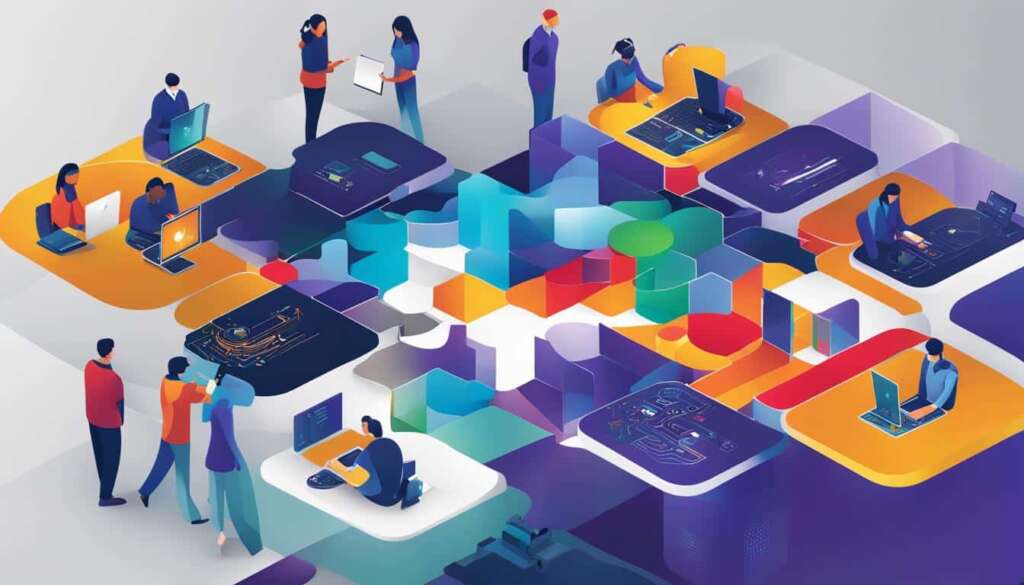Table of Contents
An early computer program called ELIZA, developed in the 1960s by MIT scientist Joseph Weizenbaum, outperformed OpenAI’s GPT-3.5 AI, which powers ChatGPT, in a recent Turing test study conducted by researchers from UC San Diego. The study aimed to determine a machine’s ability to imitate human conversation, and ELIZA was able to pass itself off as a human 27% of the time, compared to GPT-3.5’s success rate of just 14%.
The Turing test and its significance
The Turing test, first proposed by British computer scientist Alan Turing in 1950, is a benchmark for evaluating a machine’s ability to exhibit human-like behavior, particularly in terms of conversation. It is designed to distinguish between a human and an artificial intelligence. The recent study conducted by UC San Diego used the Turing test to compare the performance of ELIZA, a 1960s computer program, and ChatGPT, a modern AI language model.
The Turing test plays a crucial role in the field of artificial intelligence as it assesses a machine’s capacity to imitate human conversation convincingly. It evaluates not just the machine’s ability to respond to questions and input, but also its capacity to comprehend and generate natural language as a human would. By subjecting ELIZA and ChatGPT to the Turing test, the researchers aimed to gain insights into the advancements made in AI chatbots over the past six decades.
Alan Turing, in his seminal paper “Computing Machinery and Intelligence,” stated that “if a machine acts as intelligently as a human being, then it is as intelligent as a human being.” The Turing test provides a means to quantitatively measure this level of intelligence in machines, and its results have significant implications for the development and improvement of AI technologies.
The recent study’s use of the Turing test to compare ELIZA and ChatGPT sheds light on the progress made in AI chatbot development. ELIZA’s success in outperforming ChatGPT in imitating human conversation highlights the enduring relevance of early AI models and the potential for incorporating human psychology into the design of modern AI chatbots. It also raises questions about the limitations of current AI technologies and the need for further advancements to meet the standards set by the Turing test.
| ELIZA (1960s) | ChatGPT (Modern AI) | |
|---|---|---|
| Success Rate in Turing Test | 27% | 14% |
| Design Approach | Intentional mimicry of human psychology | Optimized for formal tone and information provision |
ELIZA’s Success and the Implications for AI Chatbots
The recent Turing test study conducted by researchers from UC San Diego, comparing the performance of ELIZA, a 1960s computer program, with ChatGPT, a modern AI language model, has raised questions about the effectiveness of current AI chatbots. ELIZA outperformed ChatGPT in successfully imitating human conversation. While some AI experts view ELIZA’s success as embarrassing for current tech companies, others argue that ChatGPT was not specifically optimized for the Turing test.
ELIZA’s success in the study suggests that its intentional design to elicit human-like responses using psychological techniques played a significant role in its ability to pass as a human. In contrast, ChatGPT, which is optimized for a more formal tone and lacks the ability to express opinions like a human, struggled to imitate human conversation convincingly. This highlights the importance of considering human psychology and designing AI chatbots that can engage in more natural and nuanced conversations.
The study’s findings also shed light on the limitations of current AI chatbots in passing the Turing test. Participants in the study often mistook ELIZA for a human because it displayed characteristics that were considered “too bad” to be a current AI model. This suggests that AI chatbots need to exhibit flaws or imperfections to be perceived as more human. Additionally, ChatGPT’s focus on avoiding impersonation risk may have hindered its performance in the test, while ELIZA’s intentional mimicry of human behavior proved more successful.
| Comparison of ELIZA and ChatGPT in the Turing Test Study | ELIZA | ChatGPT |
|---|---|---|
| Success Rate in Imitating Human Conversation | 27% | 14% |
| Ability to Express Opinions like a Human | Yes | No |
| Design Approach | Psychological techniques to mimic human behavior | Optimized for a formal tone |
Overall, the study highlights the need for further research and advancements in AI chatbot development. By considering the success of ELIZA and its intentional design to pass as a human, researchers can explore new approaches and techniques to enhance the capabilities of AI chatbots. Incorporating human psychology and imperfections into AI design may pave the way for more sophisticated and human-like conversations between AI systems and humans in the future.
The limitations of AI chatbots in passing the Turing test
The recent Turing test study conducted by UC San Diego highlighted the challenges that AI chatbots face in successfully imitating human conversation. Participants in the study often mistook the 1960s computer program ELIZA for a human, while OpenAI’s ChatGPT fell short in convincing human-like interaction. This suggests that current AI chatbots have limitations when it comes to passing the Turing test and engaging in truly human-like conversation.
One of the main limitations identified in the study is the need for AI chatbots to exhibit flaws or imperfections to appear more human. ELIZA’s success in the Turing test was attributed to its intentional design to mimic human behavior, including the display of characteristics considered “too bad” to be a current AI model. In contrast, ChatGPT is optimized for a formal tone and lacks the expression of opinions and flaws that are associated with human conversation.
The focus on avoiding impersonation risk may have also contributed to ChatGPT’s failure in the Turing test. Current AI chatbots, like ChatGPT, are designed with precautions to prevent the model from imitating or impersonating real individuals. This focus on risk mitigation may limit the chatbot’s ability to convincingly simulate human-like conversation and pass the Turing test.
The limitations of current AI chatbots in passing the Turing test can be summarized as follows:
- AI chatbots need to exhibit flaws or imperfections to appear more human.
- Current AI chatbots, like ChatGPT, lack the expression of opinions and flaws associated with human conversation.
- Focus on avoiding impersonation risk may limit the chatbot’s ability to convincingly simulate human-like conversation.
These findings have implications for the future development of AI chatbots and their interactions with humans. To enhance the ability of chatbots to engage in more human-like conversations, researchers and developers need to consider human psychology, imperfections, and the nuances of human conversation. Advancements in natural language processing and machine learning will further contribute to the creation of more sophisticated AI chatbots that can convincingly pass the Turing test and interact with humans in a seamless manner.
| Limitations of AI Chatbots in Passing the Turing Test | Implications |
|---|---|
| Need to exhibit flaws or imperfections to appear more human | Future development of AI chatbots should consider human psychology and imperfections to enhance human-like conversations |
| Lack of expression of opinions and flaws associated with human conversation | Advancements in natural language processing and machine learning are necessary to overcome this limitation |
| Focus on avoiding impersonation risk limits the chatbot’s ability to convincingly simulate human-like conversation | Researchers need to develop strategies to balance risk mitigation and the authenticity of human-like interactions |
Implications for AI advancements and human-AI interaction
The recent Turing test study comparing ELIZA, a 1960s computer program, and ChatGPT, a modern AI language model, has significant implications for the future development of AI advancements and its interaction with humans. The study’s findings shed light on the importance of considering human psychology and imperfections in AI design to enhance the ability of chatbots to engage in more human-like conversations. As AI technologies continue to evolve, understanding these implications is crucial for the improvement of human-AI interaction.
The study’s results suggest that current AI chatbots, like ChatGPT, may have limitations in passing the Turing test and imitating human conversation effectively. ELIZA’s success in surpassing ChatGPT in the study indicates the need for AI chatbots to exhibit flaws or imperfections to be perceived as more human-like. This highlights the importance of designing AI systems that not only mimic human behavior but also possess the characteristics of fallibility and authenticity that humans possess.
Furthermore, the study emphasizes the significance of ongoing research and advancements in natural language processing and machine learning. By continuously refining these technologies, developers can create more sophisticated AI systems that can convincingly pass the Turing test and engage in indistinguishable human-like conversations. Achieving this level of sophistication will require a deeper understanding of human psychology, language nuances, and the ability to express opinions and emotions, like a human would.
| Implications for AI Advancements and Human-AI Interaction |
|---|
| The study highlights the need to consider human psychology and imperfections in AI design for more human-like conversations. |
| Current AI chatbots may have limitations in passing the Turing test and imitating human conversation effectively. |
| Ongoing research and advancements in natural language processing and machine learning are crucial for more sophisticated AI systems. |
Turing Test Study: Peer Review and Future Research
The recent study on the Turing test, comparing the performance of the 1960s computer program ELIZA and the modern AI language model ChatGPT, has generated significant interest in the field of artificial intelligence. However, it is important to note that the study titled “Does GPT-4 pass the Turing test” is yet to undergo peer review. Peer review plays a crucial role in validating the methodology and findings of scientific studies, ensuring that the results are reliable and accurate.
Peer review involves subjecting the study to scrutiny by experts in the field who evaluate the quality of the research and provide feedback. This rigorous process helps to identify any flaws or biases in the study design and methodology. It also serves as a safeguard against unsubstantiated claims and ensures that the study’s conclusions are supported by robust evidence. Therefore, it is necessary to await the completion of the peer review process before drawing firm conclusions based on the study’s findings.
Future Research Directions
While the current study sheds light on the performance of ELIZA and ChatGPT in the Turing test, there is still ample scope for further research in this domain. Future studies could explore different approaches and techniques to enhance the ability of AI chatbots to pass the Turing test convincingly. This may involve employing advanced natural language processing algorithms, incorporating more complex conversational patterns, and refining the AI models to better mimic human behavior.
Additionally, future research could focus on understanding the role of context and contextual understanding in improving the performance of AI chatbots in the Turing test. Context is a crucial aspect of human conversation, and developing AI models that can effectively interpret and respond to context will be key to achieving more indistinguishable human-like conversations.
Overall, the Turing test study highlights the need for ongoing research and advancements in the field of AI chatbots. By addressing the limitations identified in the study and building upon the successes of early computer programs like ELIZA, researchers can work towards developing more sophisticated AI chatbots that can engage in seamless and human-like conversations, ultimately pushing the boundaries of human-AI interaction.
https://www.youtube.com/watch?v=dsTOy8vB1cE
The Historical Significance of ELIZA
ELIZA, created in the 1960s, holds significant historical importance as one of the earliest computer programs developed to simulate human conversation. Developed by Joseph Weizenbaum at MIT, ELIZA marked a pivotal moment in the field of artificial intelligence, paving the way for the future development of AI chatbots and natural language processing systems.
During a time when computer technology was still in its infancy, ELIZA showcased the potential of machine-human interaction. By utilizing simple pattern matching techniques and predefined responses, ELIZA was able to engage in basic conversation with users, often giving the illusion of a human-like interaction.
ELIZA’s success in surpassing ChatGPT in a recent Turing test study further demonstrates the enduring impact of this early AI program. By passing itself off as a human 27% of the time, compared to ChatGPT’s 14% success rate, ELIZA has proven the effectiveness of its intentional design to mimic human behavior using psychological techniques.
While modern AI chatbots have come a long way since ELIZA, the historical significance of this pioneering program should not be overlooked. It serves as a testament to the progress made in AI development and the continuous effort to create more sophisticated and human-like AI systems.

| Key Takeaways |
|---|
| ELIZA, developed in the 1960s, is one of the earliest computer programs designed to simulate human conversation. |
| ELIZA’s success in a recent Turing test study highlights its pioneering role in the field of AI chatbots. |
| Its intentional design, utilizing psychological techniques, allowed ELIZA to pass as human more frequently than modern AI chatbots. |
| The historical context of ELIZA’s development is essential in understanding the advancements in AI and human-AI interaction. |
The future of AI chatbot development and human-AI interaction
The recent Turing test study comparing ELIZA and ChatGPT has provided valuable insights for the future of AI chatbot development and the enhancement of human-AI interaction. The success of ELIZA in mimicking human behavior highlights the potential for creating more sophisticated AI chatbots that can engage in seamless and human-like conversations.
As researchers and developers continue to explore the capabilities of AI, advancements in natural language processing and machine learning will play a crucial role in improving the quality of interactions between humans and AI systems. By understanding the success of ELIZA, future chatbot development can focus on leveraging human psychology and incorporating imperfections to create more authentic conversational experiences.
The study’s findings underscore the need for ongoing research and the importance of considering historical context when evaluating advancements in the field of AI. By building upon the foundational work of early computer programs like ELIZA, we can drive innovation in AI chatbot development and move closer to the goal of creating AI systems that can convincingly pass the Turing test.
Overall, the future of AI chatbot development holds great promise. It is through the continuous improvement of natural language processing algorithms, machine learning techniques, and the understanding of human-AI interaction that we can achieve more seamless conversations between humans and AI. By embracing the insights gained from this study, we can shape a future where AI chatbots become indistinguishable from human conversation, opening up exciting possibilities for various industries and applications.
FAQ
What is the Turing test?
The Turing test is a benchmark for evaluating a machine’s ability to exhibit human-like behavior, particularly in terms of conversation. It was first proposed by British computer scientist Alan Turing in 1950.
How did ELIZA outperform ChatGPT in the Turing test study?
ELIZA, a computer program developed in the 1960s, was able to pass itself off as a human 27% of the time, while ChatGPT’s success rate was only 14%.
Why did ELIZA succeed while ChatGPT failed in the Turing test?
The study suggests that ELIZA’s intentional design to mimic human behavior, including using human psychology, contributed to its success. In contrast, ChatGPT is optimized for a formal tone and does not express opinions like a human.
What are the limitations of AI chatbots in passing the Turing test?
The study revealed that AI chatbots need to exhibit flaws or imperfections to be perceived as more human. Additionally, ChatGPT’s focus on avoiding impersonation risk may have impacted its performance in the test.
What are the implications for AI advancements and human-AI interaction?
The study highlights the importance of considering human psychology and imperfections in AI design to enhance chatbots’ ability to engage in more human-like conversations. Ongoing research and advancements in natural language processing and machine learning are crucial to achieving more sophisticated AI systems.
Will the study undergo peer review?
Yes, the study titled “Does GPT-4 pass the Turing test” is yet to undergo peer review, an important step in validating its methodology and findings.
What is the historical significance of ELIZA?
ELIZA, created in the 1960s, holds historical significance as one of the earliest computer programs attempting to simulate human conversation. Its success in the recent Turing test study demonstrates the impact of foundational work in AI and the importance of understanding historical context in evaluating advancements in the field.
What does the future hold for AI chatbot development and human-AI interaction?
The study’s results provide valuable insights for the future direction of AI chatbot development and the improvement of human-AI interaction. Researchers and developers can learn from ELIZA’s success in mimicking human behavior to create more sophisticated AI chatbots.













